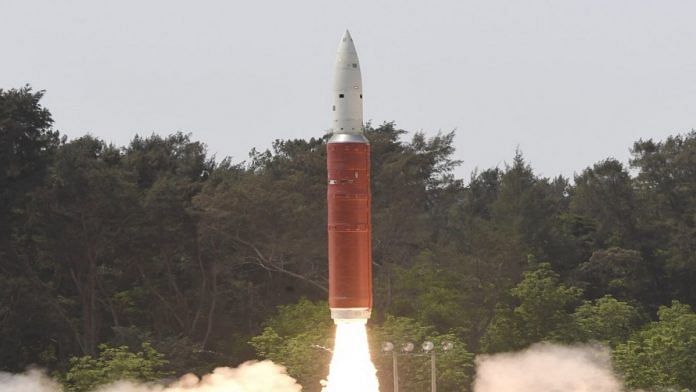New Delhi: India is not planning to carry out a second test of its anti-satellite (A-SAT) missile, either in lower or higher orbits, after the maiden test earlier this year ticked off all the checkboxes, ThePrint has learnt.
However, work will continue on improving the missile and technology, said sources.
“There is no second A-SAT test that is being planned. The first test was fully successful. We have proven our capability to the world. Fine-tuning of the systems will of course take place to provide it with more lethality,” a top government official told ThePrint.
India had successfully test-fired an anti-satellite missile on 27 March, knocking off one of its own satellites 300 km in space, thereby joining a small group of countries — the US, Russia and China — to possess such a capability.
Soon after, Defence Research and Development Organisation (DRDO) Chairman G. Sateesh Reddy ruled out future A-SAT missile tests in the lower Earth orbit, but hinted at keeping the options open for possible experiments in higher orbits.
Reddy said the interceptor used for the A-SAT missile test had the capability to hit targets 1,000 km away, but DRDO had intentionally chosen the target at an altitude of 283 km to prevent the creation of space debris.
The interceptor missile was a three-stage missile with two solid rocket boosters.
While there are other ways to demonstrate A-SAT capabilities such as “fly-by tests” and jamming, India had relied on the “kinetic kill technology”.
Also read: At 70, why NATO is tense and divided, grappling with deep political fissures
The main challenger
Officials have said in the past that Indian scientists moved towards the A-SAT test after China proved its capabilities in space and conducted the test in 2007 at an altitude of 865 km.
The Indian A-SAT technology came as a by-product of the Ballistic Missile Defence Programme.
In the mid-2000s, India secured Swordfish, an Indian active electronically scanned array (AESA) long-range tracking radar, specifically developed to counter the ballistic missile threat.
The radar is a derivative of the Israeli Green Pine long-range radar, which is a critical component of the country’s Arrow missile defence system.
During trials for the anti-ballistic missile systems, DRDO noticed that the radar was so powerful that it could even track satellites in lower Earth orbits of about 600 km.
When China carried out its test, the DRDO rushed to the government stating that it too could develop such a missile.
Given the wide condemnation that China attracted, the DRDO was asked by the government to focus on the anti-ballistic missile systems.
Chinese threat
While India has proved its space capabilities now, the Chinese threat persists.
In a review of Indian A-SAT missile test, think tank Carnegie Endowment for International Peace said the Chinese counter-space strategy since 2007 has clearly shifted in the direction of emphasising nondestructive means of space denial whenever possible.
“The available evidence suggests that China is currently pursuing several different alternatives, all of which singly or in combination would deeply threaten India’s ability to use space for civilian or military purposes in crises or in wartime,” it said.
It also noted that China’s counter-space capabilities are wide-ranging, highly diverse, and span the entire intersection of lethality and reversibility.
This includes capability to carry out sophisticated cyber attacks directed at ground stations with the intent of either corrupting or hijacking the telemetry, tracking, and command systems used to control various spacecraft on orbit.
“They also involve huge investments in developing ground-, air-, and space-based radio frequency jammers that target the uplinks, downlinks, and crosslinks involved in either the control of space systems or the transmission of data arising from various space system activities,” the think tank said.
(Edited by Amit Upadhyaya)
Also read: DRDO and SFC to look into why nuclear-capable Agni night test failed






